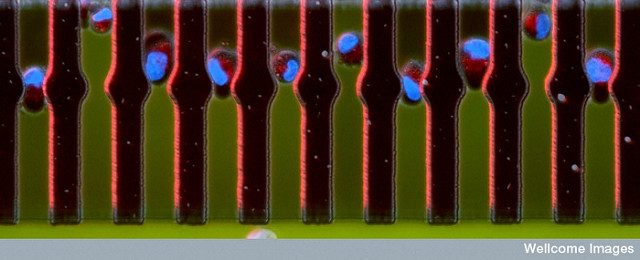Impossible to fit? Like microscopic cockroaches, cancer cells are able to fit through inconceivably tiny gaps. Two new studies bring scientists closer to understanding this ability, and their insights may open up new treatment options for aggressive cancers.
To study their movements, two independent teams of researchers at New York’s Cornell University and the French Institut Curie set up miniature obstacle courses to watch cancer cells make their way through tight gaps. Their research, published in a recent issue of Science magazine1, shows that cancer cells can squash through tiny holes, as narrow as a quarter of the cell’s width, by shattering their nucleus – a compartment that protects the cellular DNA. This causes their DNA to temporarily leak into the cell plasma before the cells can restore their nucleus. Cells with low levels of lamins – structural components of the nucleus that act as stabilisers – are more likely to pop their nucleus. This might help them form more invasive and aggressive cancers.
However, nucleus flexibility comes at a price: leaked DNA is often damaged and needs to be repaired for the cell to survive the stress of the tight squeeze. The researchers show that blocking both DNA and nucleus repair mechanisms kills the cells that were damaged by moving through tight gaps. The teams hope that in the future this weakness could be used to stop mobile cancer cells from forming distant tumour metastases, the main cause of cancer deaths.
If you want to see cancer cells pushing their way through a mini-obstacle course, watch this video from Science: https://www.youtube.com/watch?v=-lg91eM8c7U
Edited by Sarah Spence
References
- The research articles can be found here http://science.sciencemag.org/content/early/2016/03/25/science.aad7297 and here http://science.sciencemag.org/content/early/2016/03/23/science.aad7611

